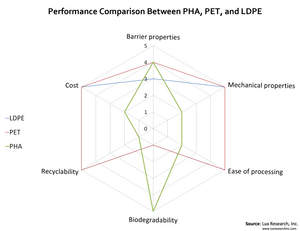BOSTON, MA--(Marketwired - Mar 31, 2015) - Bio-based polymers can displace incumbent petroleum-based polymers in a market exceeding $100 billion. They face challenges, like inferior mechanical properties and processability, that limit their potential in some high-volume markets like automotive, but their biodegradability can make them a valuable choice in markets such as biomedical and agriculture, according to Lux Research.
"Most bio-based polymers, especially polybutylene succinate (PBS), polylactic acid (PLA) and polyhydroxyalanoate (PHA), exhibit biodegradability, something most petroleum-based polymers lack. For biomedical applications and in agriculture, this biodegradability and their low toxicity are valuable," said Meraldo Antonio, Lux Research Associate and lead author of the report titled, "Comparing the Performance and Addressable Markets for Bio-based Polymers."
Lux Research analysts assessed four bio-based polymers, evaluating their performance parameters vis-à-vis the incumbent polymers -- polyethylene (PE) and polyethylene terephthalate (PET). Among their findings:
- PLA shows promise in agriculture. Innovation in PLA synthesis can help boost the mechanical properties of PLA to enable promising application in agriculture, such as mulching films that benefit from biodegradability. It can also be ideal for food packaging for products that don't require oxygen barriers.
- Biomedical apps beckon PHA. Pure PHA, like pure PLA, suffers from poor structural strength. But PHA's biodegradability and low- to non-existent toxicity opens up many potential applications within the medical and pharmaceutical industries, such as sutures, bone plates, grafts and a wide variety of implants.
- Medicine, packaging appeal to PBS. PBS has properties comparable to incumbent polypropylene but costs twice as much. Still, it has important applications in the medical industry because it presents better processability and toxicity than PLA, and exhibits mechanical properties comparable to polypropylene and PE.
The report, titled "Comparing the Performance and Addressable Markets for Bio-based polymers," is part of the Lux Research Bio-based Materials and Chemicals Intelligence service.
About Lux Research
Lux Research provides strategic advice and ongoing intelligence for emerging technologies. Leaders in business, finance and government rely on us to help them make informed strategic decisions. Through our unique research approach focused on primary research and our extensive global network, we deliver insight, connections and competitive advantage to our clients. Visit www.luxresearchinc.com for more information.
Contact Information:
Contact:
Carole Jacques
Lux Research, Inc.
617-502-5314
carole.jacques@luxresearchinc.com
